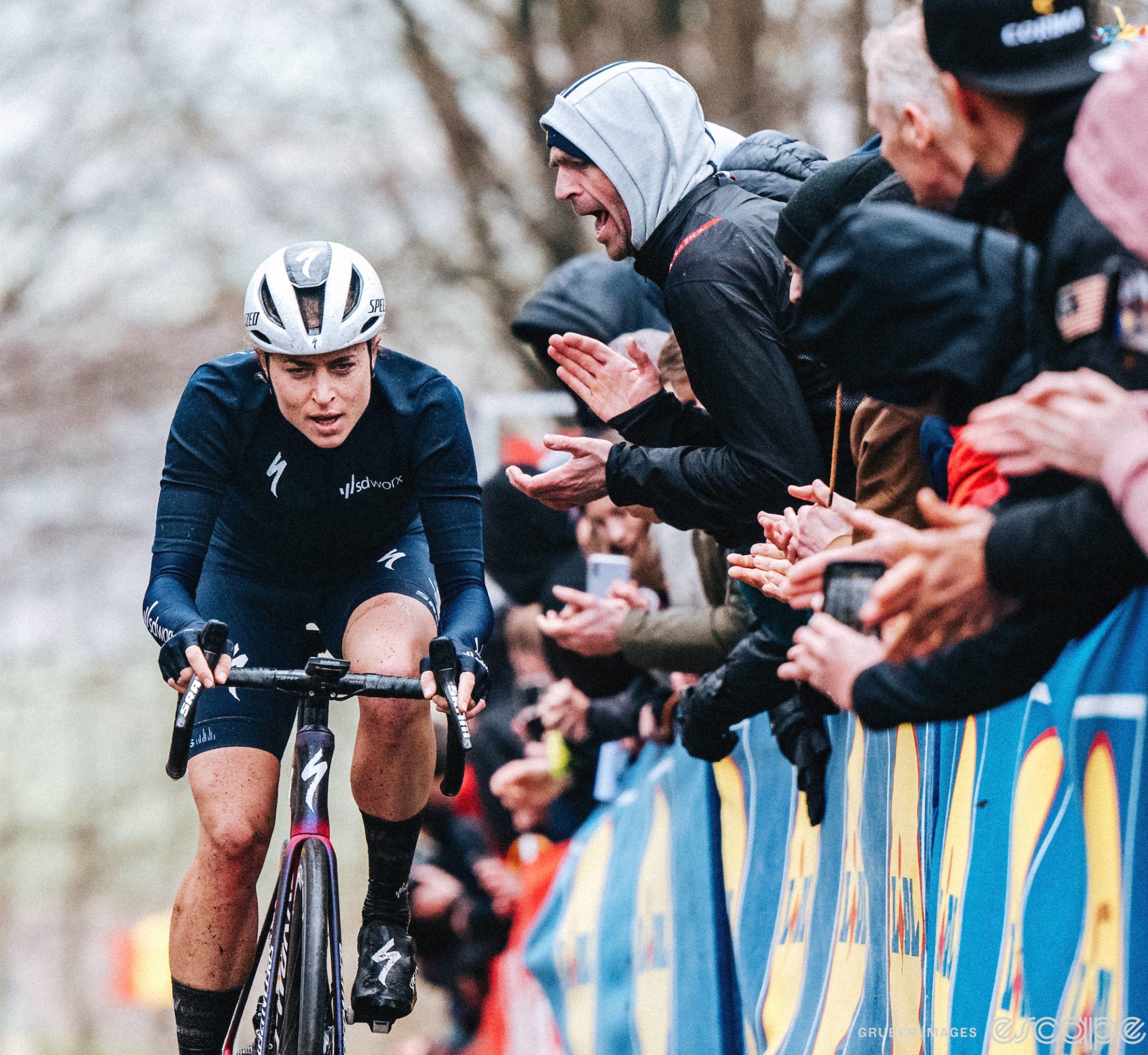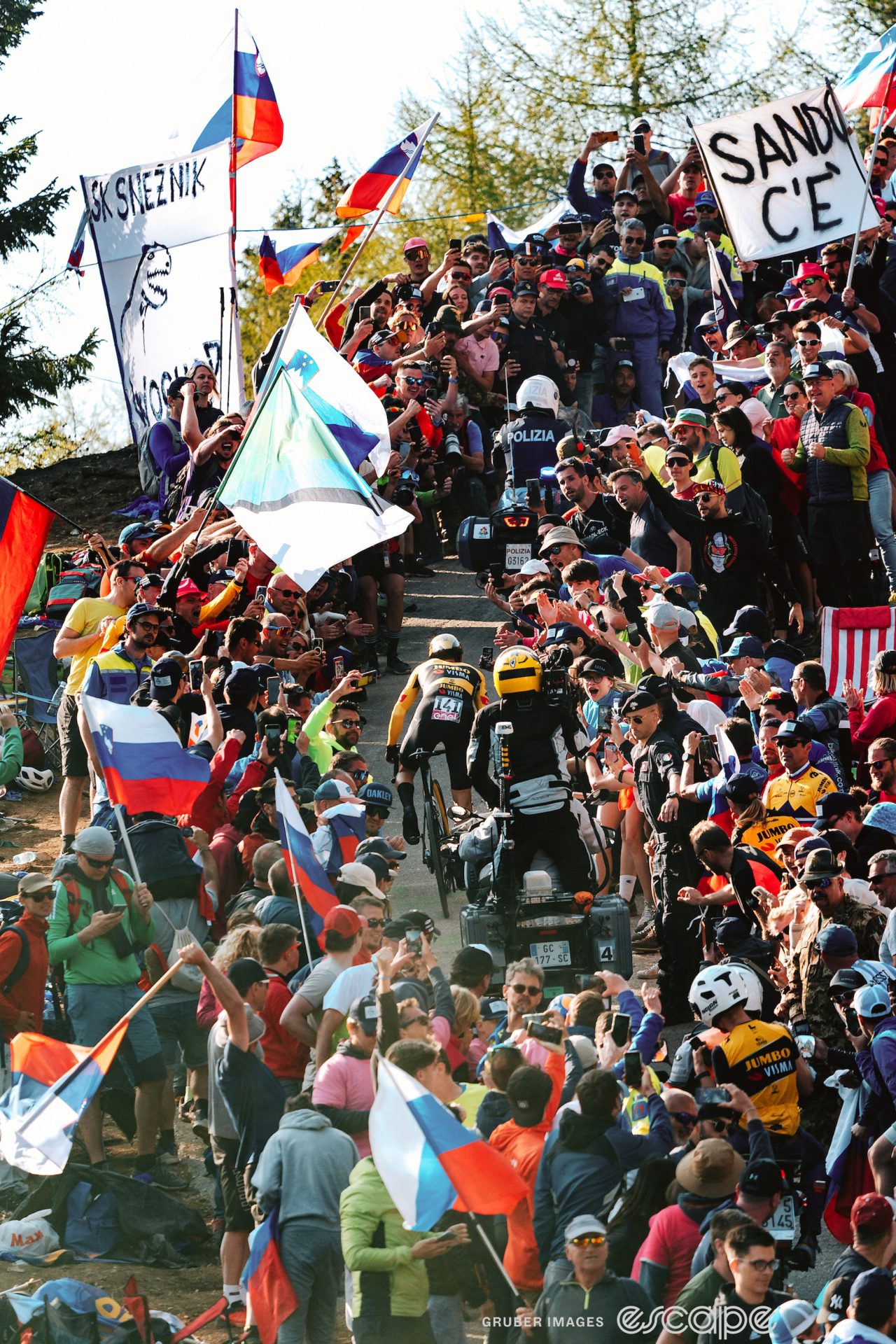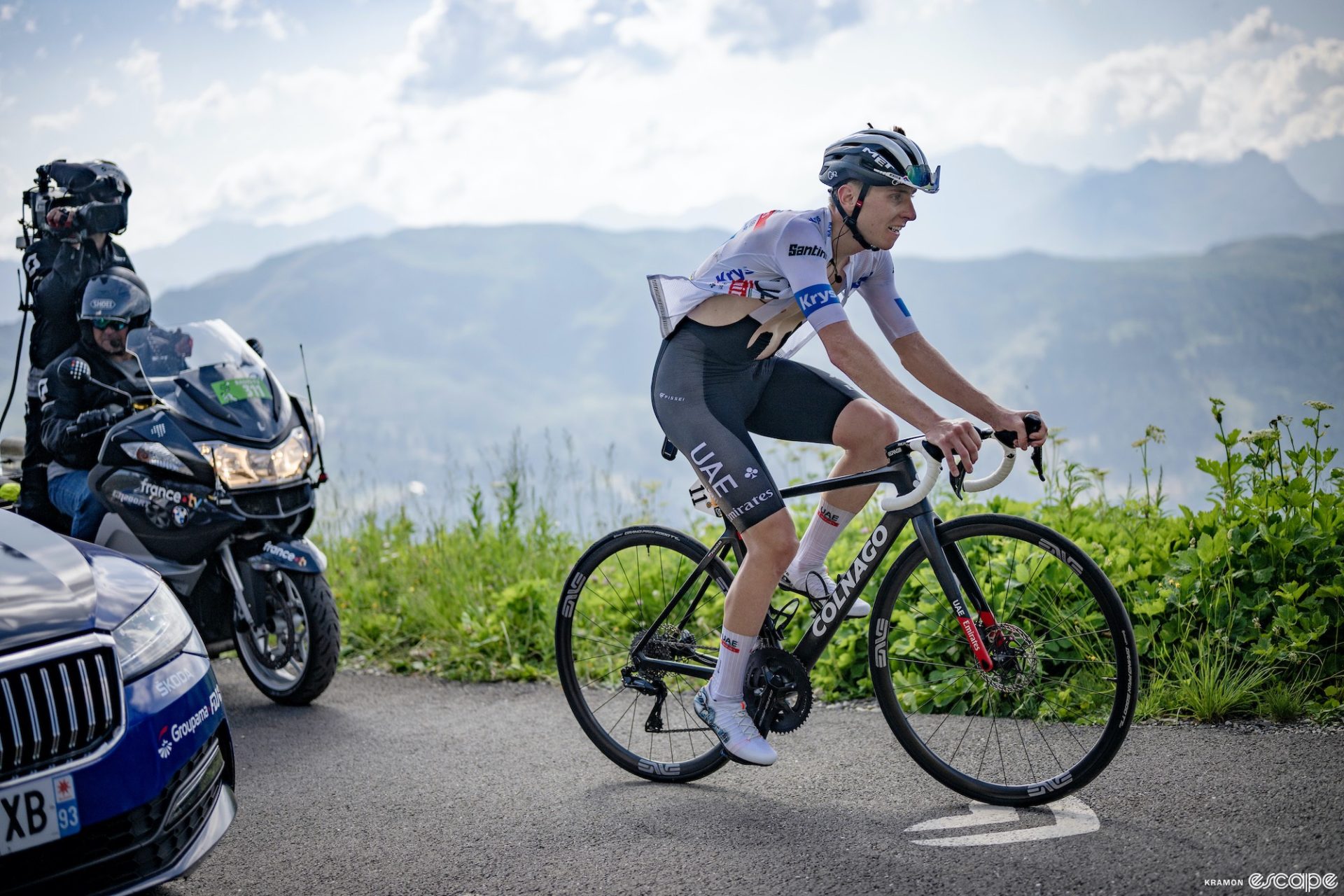As 2023 comes to a close, we here at Escape Collective have been looking back on what was a thoroughly thrilling road racing season. From Alison Jackson’s stunning victory at Paris-Roubaix to a Tour de France battle for the ages, this year was jam-packed with drama that we will remember for years to come.
With that in mind, we put our heads together to decide on which of those many moments stood out as particularly noteworthy. It was not easy to narrow things down across such a long and excellent season, but Dane Cash, Joe Lindsey, Abby Mickey, Kit Nicholson, and Jonny Long tried anyway.
Here are seven moments that defined the 2023 season for us …
Marlen Reusser’s long solo at Gent-Wevelgem heralds a breakout season
Heading into the 2023 season, SD Worx was already clearly the dominant team in women’s racing. And the roles broke down neatly: Demi Vollering was the star for hilly one-days and stage races; Lorena Wiebes would mop up the sprints; and Lotte Kopecky was your all-around Classics threat. Marlen Reusser would dominate the time trials, but her other role was to be the tractor that neutralized all breakaways, the woman you simply could not ride away from. As it turned out, she was also the woman who could ride away from almost anyone.

And she did, starting at Gent-Wevelgem, with that little “What, attack? Me?! I’m not attacking. I’m just, you know, riding away from you,” move with 40 km to go. You can argue that Reusser was able to slip away because everyone behind was watching Kopecky, who was watching everyone else. And you wouldn’t be wrong. But Reusser then proceeded to put over two minutes into the chase on a raw, wet day when riders were soaked to the bone and the slightest mistake – a misplaced tire in a concrete expansion gap, forgetting to fuel properly – could have spelled disaster, as it did for Wiebes when she crashed in a muddy gutter trying to move up. (Indeed, even a brief off-course foray couldn’t derail Reusser’s chances.)
That was the start of what turned out to be the most successful season by far in Reusser’s career: eight wins, two of them overall victories, as she became a rider of impressive range, strength, and tactical mastery (not to mention humanity). More than that, Reusser’s emergence is, as much as anything, what enabled SD Worx’s tactical domination of the sport this year. She was the ultimate puzzle for other teams: the rider you couldn’t let go, and the rider who wouldn’t let you go either. Solving that (ha!) is the first step to figuring out how to beat them.
—Joe Lindsey
Alison Jackson shocks the world to win Paris-Roubaix
After watching only two editions of Paris-Roubaix Femmes avec Zwift so far, we sat very firmly in the unknown for the race this year. What kind of tactics and rider can win this event? We’ve had years of watching the chaos of the men’s race, but women’s racing is so different, the two can’t be compared to each other. Paris-Roubaix specifically is impossible to predict. The first edition, after having a bit of a disappointing year, was won in commanding style by Lizzie Deignan, thanks in large part to the horrendous weather. The following year was won by her teammate Elisa Longo Borghini, another surprise victory as the Italian had struggled up to that point with illness.

Ahead of the third edition, while writing the preview, I didn’t know how to predict the unpredictable, so I called up Alison Jackson to see what she thought of the situation, how the peloton was handling the SD Worx onslaught, and how she personally was going to tackle the race. She told me the best way to beat SD Worx, and everyone else, was to get ahead of the race early on. In fact, that was exactly what she was planning to do.
A few days later, the world watched in awe as Jackson not only executed the plan she’d laid down for me on Wednesday, but gave the race everything she had. Into the velodrome, with the chasers uncomfortably close, it was clear Jackson had expended the most energy of anyone in the early move, but it didn’t matter. She found something extra that day and sprinted to victory, becoming the first Canadian (and North American) to win Paris Roubaix (men’s or women’s).
Jackson’s win left the cycling world speechless, in tears, or laughing uncontrollably especially when she followed it up with a dance right there on the edge of the track. It was a win that will live rent-free in the minds of so many for years to come, a real life story of the underdog victorious against an army hellbent on their own glory. It was an in-your-face example of why Paris-Roubaix is such an iconic race, because no matter what you think is going to happen, you need to go into it with the knowledge that things won’t always go to plan – even though for Jackson that day, things went exactly as she had always dreamed.
—Abby Mickey
Primož Roglič comes from behind to take a cathartic Giro victory
The unprecedented Jumbo-Visma sweep at the Vuelta a España and – especially – the way it came about might lead to the easy conclusion that it was the wildest of the three Grand Tours this year. But consider for a moment the 2023 Giro d’Italia, which started off looking like it was Remco Evenepoel’s to lose before he DNF’d with Covid-19. Then, the vaunted team strength of Ineos Grenadiers crashed out along with Tao Geoghegan Hart. Finally, Geraint Thomas’s own bid came undone on the next-to-last day of the race, in spectacular fashion.

The Monte Lussari time trial might not grow in the telling the next many years, but that’s only because the whole baroque masterpiece was so classically Giro from the start. A stage of two halves, with a dead-flat start followed by a 1,000-meter climb at 11% average up, basically, a golf cart path, so narrow team cars couldn’t follow. Three waves, with intermezzos in between to let the follow motos descend back to the start of the out-and-back road. An F1-style pit zone for bike changes. Ending at an almost too-perfectly photogenic monastery perched improbably on a sheer peak, thronged with crowds of Slovenian-flag waving fans, as if created expressly for your desktop screen saver.
Then there was the racing. Specifically, the battle between Thomas and Roglič for the overall, and separated by just 29 seconds. Thomas was down just two seconds at the bike swap time check, although a helmet swap of questionable leisurely-ness cost eight more. It would be tight, but surely he had it sewn up. Then, a sensation like a million Slovenians crying out in terror as Roglič somehow managed to ship the chain on a narrow-wide 1x drivetrain – with a chain keeper! – before an improbably positioned former ski-jumping pal gave him a push to get going again. How loud did you yell at your TV – be honest. And then! Roglič somehow gaining back not only those 18 precious seconds, but putting in 24 more, over the last three kilometers of racing?! More sports yelling.
For Roglič to win, and to win in such poetic fashion as the mirror image of his heartbreaking 2020 Tour de France loss, to win so close to Slovenia, to let out that cathartic roar on the podium, was nothing less than the answer to the question: Why do you watch sports?
—Joe Lindsey
“I’m gone. I’m dead.” Tadej Pogačar cracks at the Tour de France
There was a time not that long ago when diehard cycling fans would bemoan the transformation of the sport’s biggest event into a borefest – but those troubled times were a distant memory this past July when Jonas Vingegaard and Tadej Pogačar put on a show for the ages. Through two weeks of racing in France, the overall standings remained impossibly tight.
Vingegaard’s stellar showing in the stage 16 time trial, however, put him ahead on the GC and it put the ball into Pogačar’s court, leaving all of us wondering whether the Slovenian wunderkind would land a counterpunch on the high-mountain stage 17 that followed.
Then, Pogačar cracked on the slopes of the Col de la Loze.

It was a moment that had everything. It was the defending Tour champ leaving perhaps the sport’s biggest star in the rearview mirror on the way up to the highest point of the 2023 Tour, and it was accompanied by what may go down as the first time that the race radio feed actually livened up a cycling broadcast.
“I’m gone. I’m dead,” Pogačar said into his radio as he cracked in the first Tour to feature audio from team radios on the live broadcast. Suddenly, the first rider since Eddy Merckx to have a Tour de France win and a Tour of Flanders win on his palmarès looked like a mortal, while Vingegaard soared upward to what would ultimately be a commanding race lead.
In the end, Vingegaard’s margin of victory was not close at all, but we were treated to an all-time duel along the way. Vingegaard’s spectacular triumph over Pogačar in the Alps, and the accompanying audio of Pogačar’s heartbreak, were the culmination of that battle. Whichever rider you were rooting for, it was a hell of a show on the sport’s biggest stage, and that’s what it’s all about.
—Dane Cash
Thibaut Pinot’s last Tour de France hurrah
You can keep your finish-line celebrations, your podium sweeps, even underdog victories – I’ll take the hopeless romantic, the valiant loser that is Thibaut Pinot, and his summative display on the Petit Ballon at the Tour de France. For me, Pinot brings to mind the French New Wave, films directed by Éric Rohmer or Agnes Varda that are replete with flourishes of colour and wandering characters that invariably leave you with a smile and a sigh – and often a question – the drama rarely paired with great spectacle.

The moment it was announced that the penultimate stage of the 2023 Tour de France would take on Pinot’s local roads, all of cycling knew that the French hero would have his name engraved on the day. He did so with one last attack from the breakaway, as passion-fuelled and ill-fated as most that came before it, leaving behind teammate and French national champion Valentin Madouas with 40 kilometres left of racing in his beloved Vosges massif. As hopeful as he and everyone watching might have been, by this point a fairytale ending was very unlikely, but that last bouncing dance on the Petit Ballon was a wonder to behold as Pinot carved a path through a cacophony of noise that was just for him, a tragic and ‘magnificent loser’ who had become a totem for French fans.
Then he was caught by the yellow jersey group, swallowed up by history as the Tour sans Pinot began. It was the perfect crest in the storied career of one of modern cycling’s most enigmatic and likeable characters.
—Kit Nicholson
Kasia Niewiadoma leaves it all on the road on the Col d’Aspin
I dare you to find many riders as beloved, inside the peloton and out, as Kasia Niewiadoma. She doesn’t win often but when she does it’s because she doesn’t hesitate to follow her heart and her gut. Much of the time it is to her detriment, leaving people yelling at their screens to do less. But doing less isn’t something Niewiadoma understands. She only ever races with her heart on her sleeve.

Heading into the Tour de France Femmes avec Zwift it was unclear if her climbing ability would be up to the challenge set forth by Demi Vollering and Annemiek van Vleuten, but going into the seventh and queen stage, the Canyon-SRAM rider sat fifth overall. As the peloton fractured Niewiadoma looked calm, collected, and in control and over the Col d’Aspin it was only three riders left: the two favorites and Niewiadoma.
So when Van Vleuten showed even a tiny bit of weakness Niewiadoma did what Niewiadoma does best … she sent it.
Now, if you’ve ever been on Niewiadoma’s wheel on a descent, trust me, you haven’t, because you can’t. On the descent, while Vollering and Van Vleuten played mind games, Niewiadoma’s best characteristic propelled her ahead of the rest.
Even as the gap to the chasers grew smaller and smaller, and eventually the Polish rider was caught and passed by the eventual winner of the Tour, Vollering, the day ended with Niewiadoma on top of the world. She may not have won the stage, but it felt to so many who love to watch her race that her style of tactics had paid off. She would finish the Tour on the overall podium.
—Abby Mickey
Teammates battle each other on the Angliru at the Vuelta a España
Stages on the Angliru, like any so-called mythical mountain, are always destined to go down in the sport’s history, but what we saw as the 2023 Vuelta a España’s ascended the harsh gradient turned on its head what we know to be professional cycling.
The look behind from Jonas Vingegaard to his flailing teammate and race leader Sepp Kuss as the Dane couldn’t bear let Primož Roglič escape up the road for his own glory, was an instant classic. By the finish line, Kuss had managed to hang on to his race lead by a mere eight seconds over Vingegaard, and the frosty atmosphere post-race was just as captivating as the day’s on-bike action.

“I also want my shot,” was the call that finally came from a (previously) publicly-ambivalent Kuss, to tell his teammates to lay down arms against him and avoid what would have been the maddest case of fratricidal implosion cycling has ever seen – and it’s not like that’s an uncompetitive category.
Vingegaard immediately realised what had happened and declared in his own interview his desire for Kuss to now win the Vuelta. Roglič agreed, with the caveat that he was mercenarily duty-bound to race for his own results. That the Slovenian would leave the team would later come as little surprise.
It was a day that defined Jumbo-Visma’s utterly dominant season, whereby the competition had been so thoroughly squashed they had nothing else to do but fight amongst themselves for victories. What had been simmering for most of the Vuelta, if not since Vingegaard emerged onto the WorldTour, came to a head on the Angliru, and the full ramifications of the day are not yet fully understood, but will shape the next few years of our sport.
—Jonny Long
Did we do a good job with this story?
